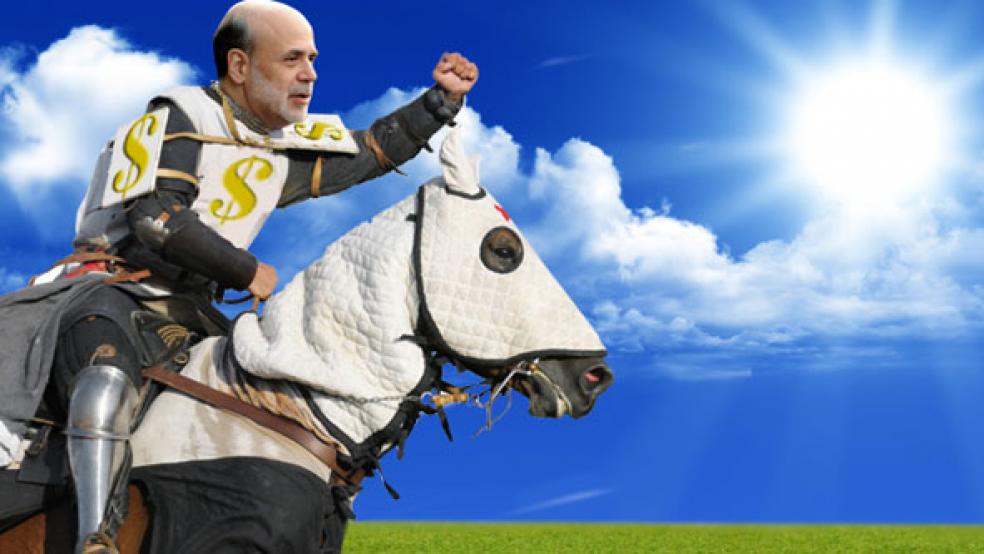The Federal Reserve has increased the size of its balance sheet nearly four-fold since the onset of the financial crisis, from around $870 billion in 2007 to $3.35 trillion today. This has caused people like Peter Schiff to predict that we are headed for a severe outbreak of inflation. An inflation problem is just round the corner we’ve been told again and again since 2008, yet inflation remains below the Fed’s two percent target, long-run inflation expectations are well-anchored, and there is little evidence in recent data that inflation is or will be a problem.
Why is inflation so low?
 The inflation rate tells us what is happening, on average, to prices in the economy. If prices are rising in most markets because demand is growing faster than supply, there will be inflation. If most prices are falling because demand is growing too slower than supply, we will have deflation.
The inflation rate tells us what is happening, on average, to prices in the economy. If prices are rising in most markets because demand is growing faster than supply, there will be inflation. If most prices are falling because demand is growing too slower than supply, we will have deflation. Presently, demand is weak because of the recession and that is one of the reasons the inflation rate is below the Fed’s two percent target. But that is not the only reason inflation is too low at a time when economic conditions call for more aggressive monetary policy. Stimulating demand and creating inflation has not been as easy as the Fed thought it would be even with the dramatic increase in the size of its balance sheet, and the Fed has been unwilling to take the additional bold and creative steps needed to bring inflation up to –– or in the short-run even above –– its target level.
Monetary policy changes the inflation rate through policies that change demand conditions in large numbers of markets. For example, a Fed induced fall in the interest rate should increase demand in markets that rely upon credit, and that should put upward pressure on prices in those markets.
One of the main ways the Fed stimulates the demand for goods and services is by giving the banks more money to lend through what are known as open market operations. But if this money simply piles up in banks as excess reserves instead of being used to make new loans to consumers and businesses, it won’t have any effect on the demand for goods and services and it won’t cause prices to rise.
Excess reserves are, in fact, piling up in banks –– from near zero before the recession to around $1.75 trillion today –– instead of flowing into the economy and offsetting the fall in demand from the recession. Because of this, demand is too low, unemployment is too high, and inflation has consistently been running below the Fed’s two percent target.

So here’s the question. Why hasn’t the Fed shown the same boldness and creativity in responding to the unemployment problem that it displayed when it needed to bail out financial institutions? When banks were in trouble, the Fed created a whole host of special facilities and pushed the rules to the limits. Some of the special facilities and polices worked out very well, others didn’t work at all, and some had unintended consequences. But the Fed was willing to take the necessary risks and that allowed it to come to the rescue of the financial system.
But now, when unemployment is the problem, the Fed seems unwilling to push the limits to the same degree. For example, the Fed could charge banks for holding excess reserves instead of paying them interest on those reserves as it does now. With such a penalty in place banks would have a much larger incentive to make loans, and some of the piled up reserves would leave banks and turn into new demand for goods and services. That’s just what the economy needs.
More aggressive, out of the box policy could speed the recovery of output and employment, and there are many other steps the Fed could take to help the economy along. It could even consider the use of helicopter money as debated recently by some of the leaders in monetary policy. But whenever such suggestions are made to the Fed the response is invariably the same. Time and again as the struggles of the working class drag on and on, financial stability –– something Chairman Bernanke was careful to point to in a recent speech –– and fear out of control inflation take precedence over more aggressive policy to help the unemployed.
We do not want to repeat the wage-price spiral problems of the 1970s and the recession of 79-82 that was needed to break the cycle. So in the long-run, we want to hit our inflation target. We also don’t want to repeat the financial meltdown we’ve just been through. But the risks of inflation and financial instability have been overblown relative to the large costs associated with high long-term unemployment and it’s time for the Fed to address the unemployment problem with the same creativity, boldness, and perseverance it displayed when banks were its main concern.



